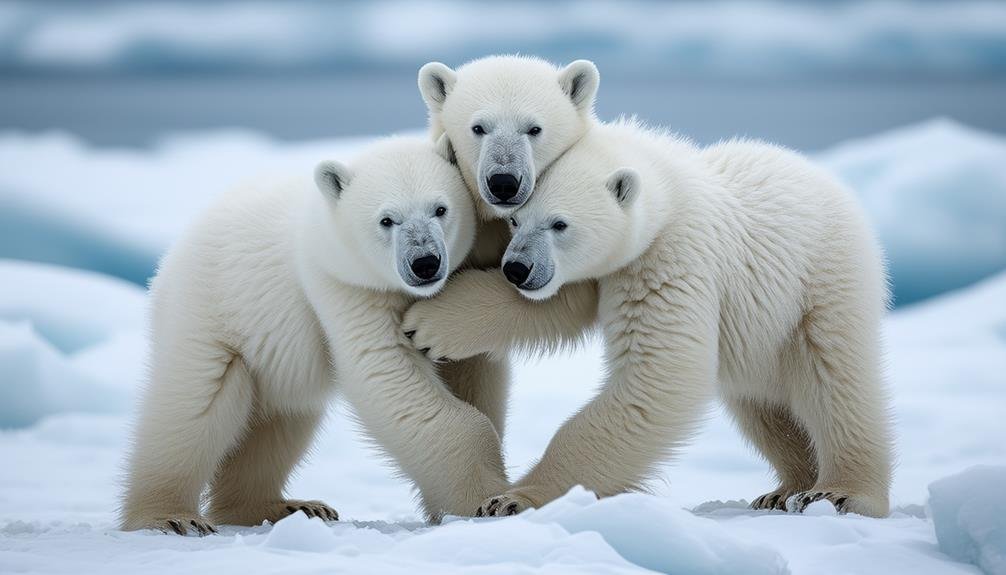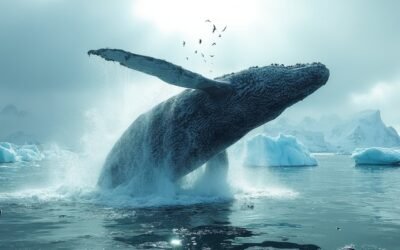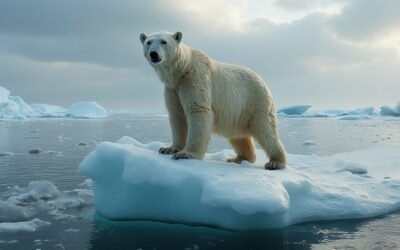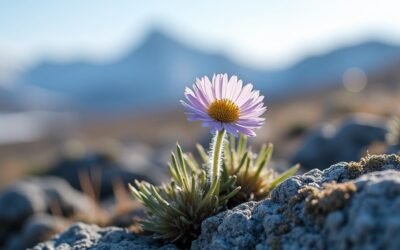Polar bear cubs engage in various winter antics that are essential for their development. Snow frolicking enhances coordination and strength through activities like snowball fights and rolling in the snow, fostering social bonds. Sliding down icy slopes helps develop balance and agility as cubs glide on their bellies, encouraging cooperative play and exploration. Playful wrestling is necessary for learning hunting and self-defense skills, reinforcing muscles and social hierarchies. These games are not only entertaining but also crucial for preparing cubs for the challenges of Arctic life. Discover more about how these activities shape their future.
Main Points
- Snowball fights and snow sculpture building enhance physical coordination and creativity.
- Sliding down icy slopes improves balance, agility, and coordination.
- Playful wrestling strengthens muscles and hones hunting and self-defense skills.
- Glacier exploration and Arctic races develop social bonds and essential survival techniques.
- Cooperative play in snow fosters social skills and prepares cubs for adult life challenges.
Snow Frolicking
Snow playing among polar bear cubs serves as an important developmental activity that enhances their physical coordination and strength. Engaging in playful activities such as snowball fights and creating snow sculptures, these young bears practice vital life skills in a safe and enjoyable environment. The act of play is not just recreational; it plays a fundamental role in the cubs' growth, allowing them to develop agility, balance, and muscle strength.
During these sessions of snow playing, polar bear cubs often exhibit behaviors such as rolling, sliding, and chasing each other through the snow. These activities simulate the movements they will need for hunting and survival as adults. The playful interaction also fosters social bonds and helps cubs learn about their environment. Constructing snow sculptures and engaging in mock snowball fights can stimulate their creativity and problem-solving abilities, further contributing to their cognitive development.
Observing polar bear cubs in these playful moments offers valuable insights into their natural behaviors and social dynamics. Such observations can inform conservation efforts by highlighting the importance of preserving their natural habitats, ensuring that future generations of polar bears can continue to thrive.
Icy Slides
In addition to snow frolicking, polar bear cubs also revel in the exhilarating activity of sliding down icy slopes, which serves as both play and essential skill development. These playful antics often involve gliding on their bellies or paws across snowy hills and icy patches. This seemingly simple activity provides much more than sheer enjoyment; it is essential for developing balance, coordination, and agility. Through these activities, cubs engage in glacier exploration and participate in what could be likened to Arctic races, honing their physical abilities in a natural and engaging manner.
Sliding down icy slopes also serves an important social function. Cubs often partake in this activity with their siblings, fostering strong bonds and learning fundamental social behaviors. Additionally, researchers believe that such sliding activities may help cubs practice hunting techniques, preparing them for the challenges of adult life in the harsh Arctic environment.
Below is a table illustrating the multifaceted benefits of icy slides for polar bear cubs:
| Activity | Skill Development | Social Benefits |
|---|---|---|
| Belly Sliding | Balance and Coordination | Bonding with Siblings |
| Glacier Exploration | Agility | Learning Social Behaviors |
| Arctic Races | Hunting Practice | Cooperative Play |
These icy slides encapsulate the essence of playful learning, vital for the cubs' survival and social integration.
Playful Wrestling

Playful wrestling among polar bear cubs serves as an essential method for honing necessary skills such as hunting and self-defense. This behavior is pivotal for their development, allowing them to engage in hunting practice and refine self-defense strategies essential for survival. Through playful wrestling, the cubs strengthen their muscles and coordination, which are fundamental for their physical development and future hunting endeavors.
Moreover, these interactions extend beyond mere physical training. Playful wrestling functions as a form of social bonding among the cubs, reinforcing relationships within their group. Through these playful encounters, cubs learn valuable lessons about communication and hierarchy within their family unit. This understanding of social structure is crucial as it prepares them for the complex social dynamics they will encounter as adults.
In the harsh Arctic environment, where survival skills are paramount, the playful wrestling sessions are more than just games. They serve as an integral part of the cubs' development, ensuring they are well-equipped to face the challenges of their environment. These playful interactions combine fun with functionality, making them a cornerstone of a polar bear cub's early life and an essential aspect of their adaptation to the Arctic wilderness.
What Winter Behaviors Make Polar Bear Cubs’ Antics So Special?
Polar bear cubs in winter display playful and curious behaviors, from sliding down ice mounds to chasing after their mother’s tail. These antics develop their strength and survival skills, while the harsh yet beautiful winter landscape provides a unique backdrop that makes their lively spirit truly captivating.
Conclusion
To wrap up, polar bear cubs display remarkable behaviors during winter, participating in activities like snow frolicking, icy slides, and playful wrestling. These behaviors not only offer essential physical exercise and social interaction but also enhance their development and survival skills. Grasping these behaviors enriches the understanding of polar bear ecology and underscores the significance of conserving their natural habitats. Ongoing research and conservation initiatives are crucial for safeguarding the welfare of these captivating creatures.


